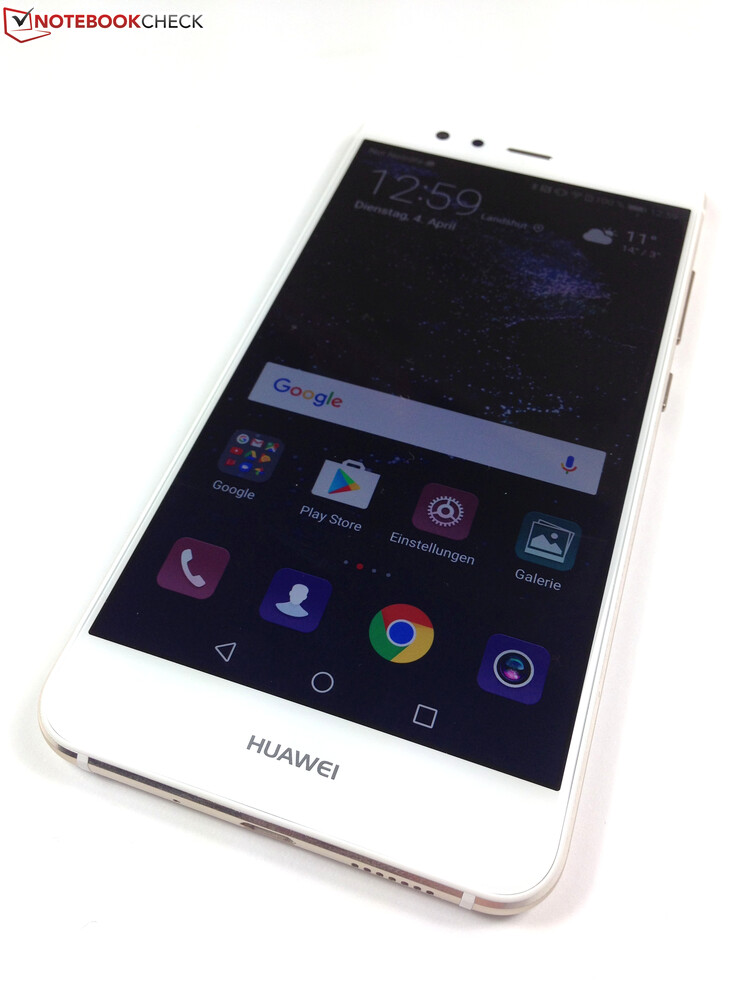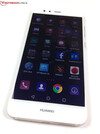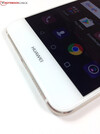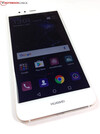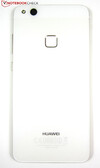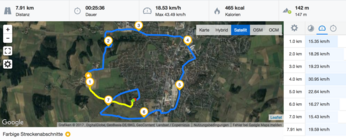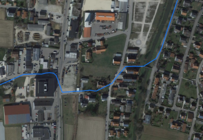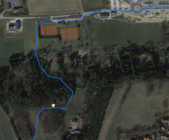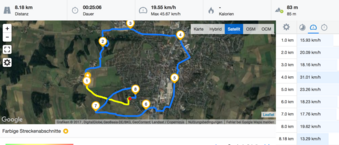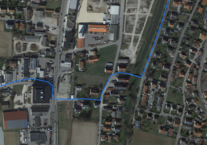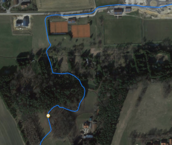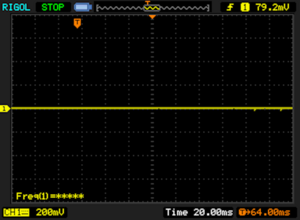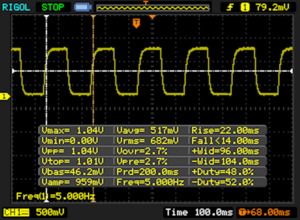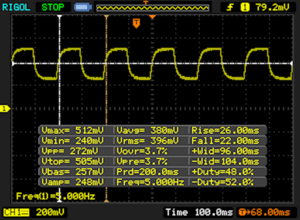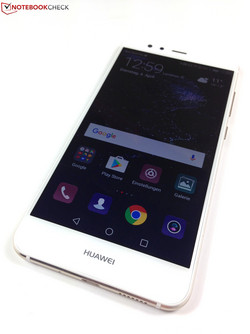Breve análisis del smartphone Huawei P10 Lite
Top 10 Análisis
» Top 10 Portátiles Multimedia
» Top 10 Portátiles de Juego
» Top 10 Portátiles de Juego ligeros
» Top 10 Portátiles Asequibles de Oficina/Empresa
» Top 10 Portátiles de Juego Ligeros
» Top 10 Portátiles de Oficina/Empresa Premium
» Top 10 Estaciones de Trabajo
» Top 10 Subportátiles
» Top 10 Ultrabooks
» Top 10 Convertibles
» Top 10 Tablets
» Top 10 Tablets Windows
» Top 10 Tablets de menos de 250 Euros
» Top 10 Phablets (>5.5")
» Top 10 Smartphones
» Top 10 Smartphones (≤5")
» Top 10 Smartphones de menos de 300 Euros
» Top 10 Smartphones de menos de 120 Euros
» Top 10 Portátiles de menos de 1000 Euros
» Top 10 Portátiles de menos de 500 Euros
» Top 10 Portátiles de menos de 300 Euros
» Los Mejores Displays de Portátiles Analizados por Notebookcheck
| Networking | |
| iperf3 transmit AX12 | |
| Huawei P10 | |
| Huawei P10 Lite | |
| Samsung Galaxy A3 2017 | |
| Honor 6X | |
| Huawei Nova Plus | |
| iperf3 receive AX12 | |
| Huawei P10 | |
| Samsung Galaxy A3 2017 | |
| Huawei P10 Lite | |
| Honor 6X | |
| Huawei Nova Plus | |
| |||||||||||||||||||||||||
iluminación: 95 %
Brillo con batería: 507 cd/m²
Contraste: 1408:1 (Negro: 0.36 cd/m²)
ΔE ColorChecker Calman: 5.1 | ∀{0.5-29.43 Ø4.78}
ΔE Greyscale Calman: 6.1 | ∀{0.09-98 Ø5}
99.8% sRGB (Calman 2D)
Gamma: 2.28
CCT: 8143 K
| Huawei P10 Lite IPS, 1920x1080, 5.2" | Samsung Galaxy A3 2017 Super AMOLED, 1280x720, 4.7" | Honor 6X IPS, 1920x1080, 5.5" | Huawei Nova Plus IPS, 1920x1080, 5.5" | Lenovo Moto G4 Plus IPS, 1920x1080, 5.5" | Huawei P10 LTPS, 1920x1080, 5.1" | |
|---|---|---|---|---|---|---|
| Screen | 34% | -10% | -4% | 1% | 2% | |
| Brightness middle (cd/m²) | 507 | 574 13% | 547 8% | 485 -4% | 609 20% | 547 8% |
| Brightness (cd/m²) | 509 | 576 13% | 540 6% | 481 -6% | 589 16% | 556 9% |
| Brightness Distribution (%) | 95 | 94 -1% | 94 -1% | 90 -5% | 87 -8% | 86 -9% |
| Black Level * (cd/m²) | 0.36 | 0.57 -58% | 0.5 -39% | 0.63 -75% | 0.43 -19% | |
| Contrast (:1) | 1408 | 960 -32% | 970 -31% | 967 -31% | 1272 -10% | |
| Colorchecker dE 2000 * | 5.1 | 2.4 53% | 5.1 -0% | 4.2 18% | 3.8 25% | 4.8 6% |
| Colorchecker dE 2000 max. * | 9 | 3.8 58% | 9.1 -1% | 7.9 12% | 8.3 8% | 8.8 2% |
| Greyscale dE 2000 * | 6.1 | 1.9 69% | 6.2 -2% | 4.8 21% | 3.1 49% | 4.5 26% |
| Gamma | 2.28 96% | 2.09 105% | 2.09 105% | 2.36 93% | 2.06 107% | 2.39 92% |
| CCT | 8143 80% | 6502 100% | 6546 99% | 7568 86% | 6725 97% | 7194 90% |
* ... más pequeño es mejor
Parpadeo de Pantalla / PWM (Pulse-Width Modulation)
| Parpadeo de Pantalla / PWM no detectado | |||
Comparación: 53 % de todos los dispositivos testados no usaron PWM para atenuar el display. Si se usó, medimos una media de 8111 (mínimo: 5 - máxmo: 343500) Hz. | |||
Tiempos de respuesta del display
| ↔ Tiempo de respuesta de Negro a Blanco | ||
|---|---|---|
| 36 ms ... subida ↗ y bajada ↘ combinada | ↗ 22 ms subida | |
| ↘ 14 ms bajada | ||
| La pantalla mostró tiempos de respuesta lentos en nuestros tests y podría ser demasiado lenta para los jugones. En comparación, todos los dispositivos de prueba van de ##min### (mínimo) a 240 (máximo) ms. » 93 % de todos los dispositivos son mejores. Eso quiere decir que el tiempo de respuesta es peor que la media (20.2 ms) de todos los dispositivos testados. | ||
| ↔ Tiempo de respuesta 50% Gris a 80% Gris | ||
| 48 ms ... subida ↗ y bajada ↘ combinada | ↗ 26 ms subida | |
| ↘ 22 ms bajada | ||
| La pantalla mostró tiempos de respuesta lentos en nuestros tests y podría ser demasiado lenta para los jugones. En comparación, todos los dispositivos de prueba van de ##min### (mínimo) a 636 (máximo) ms. » 82 % de todos los dispositivos son mejores. Eso quiere decir que el tiempo de respuesta es peor que la media (31.6 ms) de todos los dispositivos testados. | ||
| AnTuTu v6 - Total Score (ordenar por valor) | |
| Huawei P10 Lite | |
| Samsung Galaxy A3 2017 | |
| Honor 6X | |
| Huawei Nova Plus | |
| Lenovo Moto G4 Plus | |
| Huawei P10 | |
| Geekbench 4.0 | |
| 64 Bit Single-Core Score (ordenar por valor) | |
| Huawei P10 Lite | |
| Samsung Galaxy A3 2017 | |
| Honor 6X | |
| Huawei Nova Plus | |
| Huawei P10 | |
| 64 Bit Multi-Core Score (ordenar por valor) | |
| Huawei P10 Lite | |
| Samsung Galaxy A3 2017 | |
| Honor 6X | |
| Huawei Nova Plus | |
| Huawei P10 | |
| GFXBench (DX / GLBenchmark) 2.7 | |
| T-Rex Onscreen (ordenar por valor) | |
| Huawei P10 Lite | |
| Samsung Galaxy A3 2017 | |
| Honor 6X | |
| Huawei Nova Plus | |
| Lenovo Moto G4 Plus | |
| Huawei P10 | |
| 1920x1080 T-Rex Offscreen (ordenar por valor) | |
| Huawei P10 Lite | |
| Samsung Galaxy A3 2017 | |
| Honor 6X | |
| Huawei Nova Plus | |
| Lenovo Moto G4 Plus | |
| Huawei P10 | |
| GFXBench 3.0 | |
| on screen Manhattan Onscreen OGL (ordenar por valor) | |
| Huawei P10 Lite | |
| Samsung Galaxy A3 2017 | |
| Honor 6X | |
| Huawei Nova Plus | |
| Lenovo Moto G4 Plus | |
| Huawei P10 | |
| 1920x1080 1080p Manhattan Offscreen (ordenar por valor) | |
| Huawei P10 Lite | |
| Samsung Galaxy A3 2017 | |
| Honor 6X | |
| Huawei Nova Plus | |
| Lenovo Moto G4 Plus | |
| Huawei P10 | |
| GFXBench 3.1 | |
| on screen Manhattan ES 3.1 Onscreen (ordenar por valor) | |
| Huawei P10 Lite | |
| Samsung Galaxy A3 2017 | |
| Honor 6X | |
| Huawei Nova Plus | |
| Lenovo Moto G4 Plus | |
| Huawei P10 | |
| 1920x1080 Manhattan ES 3.1 Offscreen (ordenar por valor) | |
| Huawei P10 Lite | |
| Samsung Galaxy A3 2017 | |
| Honor 6X | |
| Huawei Nova Plus | |
| Lenovo Moto G4 Plus | |
| Huawei P10 | |
| PCMark for Android - Work performance score (ordenar por valor) | |
| Huawei P10 Lite | |
| Samsung Galaxy A3 2017 | |
| Honor 6X | |
| Huawei Nova Plus | |
| Lenovo Moto G4 Plus | |
| Huawei P10 | |
| Octane V2 - Total Score (ordenar por valor) | |
| Huawei P10 Lite | |
| Samsung Galaxy A3 2017 | |
| Honor 6X | |
| Huawei Nova Plus | |
| Lenovo Moto G4 Plus | |
| Huawei P10 | |
| Mozilla Kraken 1.1 - Total (ordenar por valor) | |
| Huawei P10 Lite | |
| Samsung Galaxy A3 2017 | |
| Honor 6X | |
| Huawei Nova Plus | |
| Lenovo Moto G4 Plus | |
| Huawei P10 | |
| WebXPRT 2015 - Overall (ordenar por valor) | |
| Huawei P10 Lite | |
| Samsung Galaxy A3 2017 | |
| Honor 6X | |
| Huawei Nova Plus | |
| Lenovo Moto G4 Plus | |
| Huawei P10 | |
| JetStream 1.1 - Total Score (ordenar por valor) | |
| Huawei P10 Lite | |
| Samsung Galaxy A3 2017 | |
| Honor 6X | |
| Huawei Nova Plus | |
| Lenovo Moto G4 Plus | |
| Huawei P10 | |
* ... más pequeño es mejor
| Huawei P10 Lite | Samsung Galaxy A3 2017 | Honor 6X | Huawei Nova Plus | Lenovo Moto G4 Plus | Huawei P10 | |
|---|---|---|---|---|---|---|
| AndroBench 3-5 | -19% | 9% | -10% | 9% | 174% | |
| Sequential Read 256KB (MB/s) | 264.3 | 199.7 -24% | 283.4 7% | 241.6 -9% | 271.4 3% | 738 179% |
| Sequential Write 256KB (MB/s) | 129.2 | 45.96 -64% | 73.8 -43% | 82.1 -36% | 43.48 -66% | 189.8 47% |
| Random Read 4KB (MB/s) | 72.5 | 22.32 -69% | 39.55 -45% | 35.64 -51% | 36.32 -50% | 168.4 132% |
| Random Write 4KB (MB/s) | 19.36 | 9.62 -50% | 45.05 133% | 30.12 56% | 35.79 85% | 152.3 687% |
| Sequential Read 256KB SDCard (MB/s) | 53.4 | 75.5 41% | 52 -3% | 41.64 -22% | 74.4 39% | 54.2 1% |
| Sequential Write 256KB SDCard (MB/s) | 32.7 | 50.1 53% | 34.53 6% | 33.32 2% | 46.92 43% | 32.19 -2% |
| Asphalt 8: Airborne | |||
| Configuraciones | Valor | ||
| high | 22 fps | ||
| very low | 30 fps | ||
| Dead Trigger 2 | |||
| Configuraciones | Valor | ||
| high | 51 fps | ||
(+) La temperatura máxima en la parte superior es de 34.9 °C / 95 F, frente a la media de 35.2 °C / 95 F, que oscila entre 21.9 y 247 °C para la clase Smartphone.
(+) El fondo se calienta hasta un máximo de 35 °C / 95 F, frente a la media de 34 °C / 93 F
(+) En reposo, la temperatura media de la parte superior es de 31.2 °C / 88# F, frente a la media del dispositivo de 32.9 °C / 91 F.
Huawei P10 Lite análisis de audio
(+) | los altavoces pueden reproducir a un volumen relativamente alto (#85 dB)
Graves 100 - 315 Hz
(-) | casi sin bajos - de media 27.2% inferior a la mediana
(±) | la linealidad de los graves es media (10.3% delta a frecuencia anterior)
Medios 400 - 2000 Hz
(+) | medios equilibrados - a sólo 4.6% de la mediana
(+) | los medios son lineales (5.1% delta a la frecuencia anterior)
Altos 2 - 16 kHz
(±) | máximos más altos - de media 6.8% más altos que la mediana
(+) | los máximos son lineales (5.2% delta a la frecuencia anterior)
Total 100 - 16.000 Hz
(±) | la linealidad del sonido global es media (23.4% de diferencia con la mediana)
En comparación con la misma clase
» 52% de todos los dispositivos probados de esta clase eran mejores, 8% similares, 40% peores
» El mejor tuvo un delta de 11%, la media fue 35%, el peor fue ###max##%
En comparación con todos los dispositivos probados
» 69% de todos los dispositivos probados eran mejores, 6% similares, 25% peores
» El mejor tuvo un delta de 4%, la media fue 24%, el peor fue ###max##%
Samsung Galaxy A3 2017 análisis de audio
(+) | los altavoces pueden reproducir a un volumen relativamente alto (#82.6 dB)
Graves 100 - 315 Hz
(-) | casi sin bajos - de media 19.2% inferior a la mediana
(±) | la linealidad de los graves es media (9.7% delta a frecuencia anterior)
Medios 400 - 2000 Hz
(±) | medias más altas - de media 8.7% más altas que la mediana
(±) | la linealidad de los medios es media (7.4% delta respecto a la frecuencia anterior)
Altos 2 - 16 kHz
(±) | máximos más altos - de media 5.6% más altos que la mediana
(+) | los máximos son lineales (6.9% delta a la frecuencia anterior)
Total 100 - 16.000 Hz
(±) | la linealidad del sonido global es media (26.1% de diferencia con la mediana)
En comparación con la misma clase
» 66% de todos los dispositivos probados de esta clase eran mejores, 6% similares, 28% peores
» El mejor tuvo un delta de 11%, la media fue 35%, el peor fue ###max##%
En comparación con todos los dispositivos probados
» 80% de todos los dispositivos probados eran mejores, 4% similares, 16% peores
» El mejor tuvo un delta de 4%, la media fue 24%, el peor fue ###max##%
Honor 6X análisis de audio
(±) | la sonoridad del altavoz es media pero buena (81.9 dB)
Graves 100 - 315 Hz
(-) | casi sin bajos - de media 21.7% inferior a la mediana
(±) | la linealidad de los graves es media (10.2% delta a frecuencia anterior)
Medios 400 - 2000 Hz
(±) | medias más altas - de media 8.4% más altas que la mediana
(±) | la linealidad de los medios es media (7.8% delta respecto a la frecuencia anterior)
Altos 2 - 16 kHz
(±) | máximos más altos - de media 6.7% más altos que la mediana
(+) | los máximos son lineales (5.8% delta a la frecuencia anterior)
Total 100 - 16.000 Hz
(±) | la linealidad del sonido global es media (29.1% de diferencia con la mediana)
En comparación con la misma clase
» 76% de todos los dispositivos probados de esta clase eran mejores, 3% similares, 21% peores
» El mejor tuvo un delta de 11%, la media fue 35%, el peor fue ###max##%
En comparación con todos los dispositivos probados
» 87% de todos los dispositivos probados eran mejores, 2% similares, 11% peores
» El mejor tuvo un delta de 4%, la media fue 24%, el peor fue ###max##%
| Off / Standby | |
| Ocioso | |
| Carga |
|
Clave:
min: | |
| Huawei P10 Lite 3000 mAh | Samsung Galaxy A3 2017 2350 mAh | Honor 6X 3340 mAh | Huawei Nova Plus 3340 mAh | Lenovo Moto G4 Plus 3000 mAh | |
|---|---|---|---|---|---|
| Power Consumption | 44% | -23% | 2% | -30% | |
| Idle Minimum * (Watt) | 0.38 | 0.37 3% | 0.82 -116% | 0.49 -29% | 0.63 -66% |
| Idle Average * (Watt) | 1.87 | 0.78 58% | 2 -7% | 1.63 13% | 1.91 -2% |
| Idle Maximum * (Watt) | 1.92 | 0.84 56% | 2.03 -6% | 1.76 8% | 1.96 -2% |
| Load Average * (Watt) | 3.82 | 1.52 60% | 3.34 13% | 2.98 22% | 3.88 -2% |
| Load Maximum * (Watt) | 4.9 | 2.75 44% | 4.92 -0% | 4.99 -2% | 8.74 -78% |
* ... más pequeño es mejor
| Huawei P10 Lite 3000 mAh | Samsung Galaxy A3 2017 2350 mAh | Honor 6X 3340 mAh | Huawei Nova Plus 3340 mAh | Lenovo Moto G4 Plus 3000 mAh | Huawei P10 3200 mAh | |
|---|---|---|---|---|---|---|
| Duración de Batería | 64% | 47% | 30% | 0% | 3% | |
| Reader / Idle (h) | 23.5 | 47.7 103% | 37.5 60% | 34.1 45% | 20.4 -13% | 25.7 9% |
| H.264 (h) | 9.8 | 16.5 68% | 14.8 51% | 12.2 24% | 12.9 32% | 9.7 -1% |
| WiFi v1.3 (h) | 11.1 | 11.1 0% | 16 44% | 13.7 23% | 12.3 11% | 16.1 45% |
| Load (h) | 4.8 | 8.9 85% | 6.3 31% | 6.1 27% | 3.4 -29% | 2.9 -40% |
Pro
Contra
Huawei no ha incumplido su promesa: El P10 Lite es una alternativa real al más caro (casi 600 euros), P10. Al igual que su hermano de gama alta, alardea de una fabricación excelente que lo hace parecer mucho más caro de lo 350 euros que vale. A pesar de que el P10 Lite no tiene la cámara Leica del Huawei P10, la cámara de 12 megapixels incluida muestra una gran calidad de imagen y es una alternativa mejor de lo esperada.
Nos gustó también brillante pantalla y características como la rápida WLAN, LTE Cat.6, así como la opción de funcionar con dos tarjetas SIM. A pesar de que una ocupa el espacio reservado a la ranura microSD. La duración de la batería es razonable y debería permitir al usuario llegar al final del día sin problemas.
Si no te hace falta el procesador más potente y la óptica Leica que incluye el Huawei P10, no estaría de más echar un un vistazo al Huawei P10 Lite. Con un precio de 350 Euros, el dispositivo de 5.2 pulgadas resulta una alternativa asequible a la gama P10.
Huawei ha ahorrado con el puerto USB 2.0, que hace uso del viejo conector Micro USB en lugar del Type-C, y ha decidido no permitir la instalación de aplicaciones en la tarjeta SD, lo que es una pena ya que debido a todo el software instalado, los 32 GB disponibles se quedan en unos escasos 20 GB. Al menos muchas de estas aplicaciones pueden borrarse para obtener almacenamiento. No hay nada malo con el rendimiento del SoC al menos mientras no uses el smartphone para jugar, en cuyo caso es posible que tengas que reducir los detalles para obtener una buena fluidez.
Ésta es una versión acortada del análisis original. Puedes leer el análisis completo en inglés aquí.
Huawei P10 Lite
- 04/12/2017 v6 (old)
Manuel Masiero




